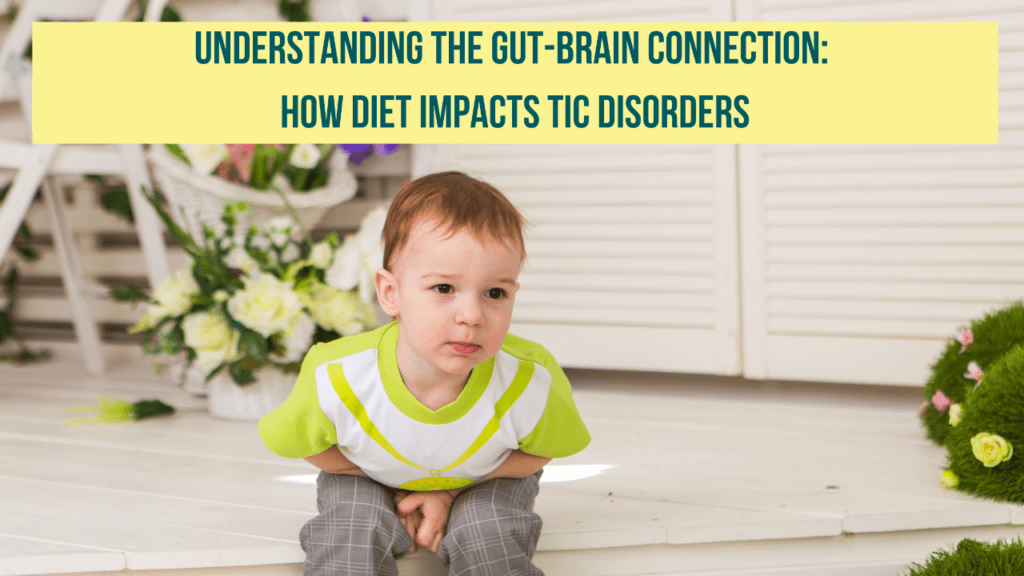Understanding the Gut-Brain Connection: How Diet Impacts Tic Disorders
For children with tic disorders, every parent asks the same question: What in the world is causing these debilitating symptoms? Though tics involve the brain and nervous system, emerging research reveals another influential factor – the gut.
Studies tell us:
- One study found that 84% of children with tic disorders also experienced chronic abdominal pain and other GI symptoms like nausea, diarrhea, and constipation (1).
- Research on PANDAS (pediatric autoimmune neuropsychiatric disorders associated with streptococcal infections) indicates that 95% of affected children suffer from GI complaints (2). PANDAS is believed to be a subtype of OCD/tic disorders.
- Some experts estimate up to 90% of children with tic disorders and related conditions like OCD have some form of GI or microbiome dysfunction contributing to symptoms (3).
I bet your doctor never told you any of this. Am I right?
The gut and brain intimately communicate along the microbiome-brain axis. When the gut microbiome becomes imbalanced through dietary choices, the fallout can impact neurological health. Understanding this connection reveals powerful ways diet can either provoke or relieve tic symptoms.
The Gut-Brain Dialogue
The gut microbiome contains trillions of microbes that produce neurotransmitters influencing brain function. When these gut bugs are thrown off balance, it disrupts the biochemical messages along the vagus nerve between the GI tract and the brain.
This can manifest in a variety of ways including inflammation, disrupted stress response, and impaired motor control – all hallmarks of tic disorders. Correcting the gut imbalance can radically improve neurological communication.
Specific dietary triggers known to disrupt gut health include:
- Sugar – Fuels overgrowth of harmful bacteria
- Artificial ingredients – Damage gut lining allowing toxins to leak
- Pesticides – Cause inflammation and alter gut bacteria
- Gluten – Can damage the gut lining in those with sensitivity
- Dairy – May trigger inflammation in sensitive children
- Additives like MSG – Excite the nervous system and stress the gut
The standard American diet high in these inflammatory compounds sets the stage for gut dysbiosis, paving the way for symptoms.
Dietary Changes for Tic Relief
Strategically remodeling your child’s diet to avoid common gut irritants while maximizing foods that nurture microbiome diversity can lead to transformative results.
- Eliminate inflammatory triggers- Ditch artificial additives, sugars,junk foods, gluten, and dairy.
- Focus on whole foods – Load up on organic fruits and vegetables, ethically raised meats, healthy fats like avocado and olive oil, and nuts/seeds.
- Consider an elimination diet – Remove potential trigger foods then slowly reintroduce one at a time.
- Try gut-healing supplements- fermented foods, omega-3s, and digestive enzymes help repair gut health. You can check out our calming bundle here
- Stay hydrated – Sip water and herbal tea throughout the day.
- Reduce pesticide exposure – Choose organic whenever possible.
- Enjoy microbiome-friendly prebiotic foods – Onions, garlic, bananas, onions, and oats feed good gut bugs.
- Address underlying food sensitivities- Testing can reveal if gluten, dairy, or other foods provoke inflammation.
However, diet is just one piece of the puzzle when it comes to managing tic disorders and gut health. While studies indicate a high rate of GI issues in this population, a whole-body approach is needed to get to the root cause for each individual.
Functional lab testing allows us to pinpoint the specific underlying factors contributing to both tics and gut dysfunction for each unique child. This comprehensive testing can reveal issues like:
- Food sensitivities triggering inflammation
- Nutritional deficiencies impairing gut health
- Dysbiosis disrupting the gut microbiome
- Toxin exposures damage the gut lining
- Immune dysfunction causing gut hypersensitivity
- Genetic defects impacting digestive function
Armed with data on the precise physiological imbalances impacting the gut and nervous system, we can then develop targeted, personalized protocols to restore balance from the inside out.
Dietary changes are just one part of the equation. We also utilize customized nutrition plans, gut-healing supplements, detoxification methods, lifestyle adjustments and more tailored to what the lab testing indicates is needed to achieve optimal wellness.
By utilizing cutting-edge functional labs, we move beyond guesswork and can pinpoint the root factors perpetuating symptoms for lasting relief. Our multi-faceted, individualized approach addresses the whole child for complete healing.
Making the Transition
Overhauling diet takes patience. Work with a nutritionist to develop a tic-friendly diet you can implement in incremental steps. Keep tempting trigger foods out of the pantry. Cook wholesome meals at home using simple recipes. Get the whole family on board to make this a lifestyle.
With time, an anti-inflammatory diet will likely yield noticeable improvements by healing the gut-brain relationship. What they eat matters – help your child build a nourishing menu that supports neurological health from the inside out.
While more research is still needed, these initial findings demonstrate a pronounced GI component in many pediatric tic disorder cases. Identifying and addressing potential gut health issues may provide an avenue for significant symptom improvement for a large subset of children.
If you want to learn more about the gut-brain connection sign up for our upcoming parent workshop on Nov. 5, 2023. Click here to register
References:
- https://onlinelibrary.wiley.com/doi/abs/10.1111/j.1651-2227.2003.tb00467.x
- https://www.tandfonline.com/doi/abs/10.1080/17460441.2022.2074396
- https://www.sciencedirect.com/science/article/abs/pii/S0889159115000849

